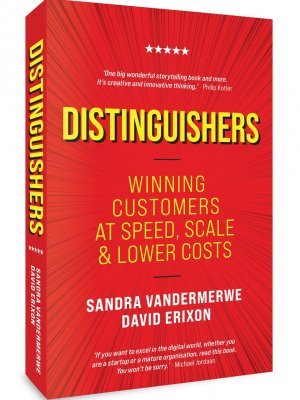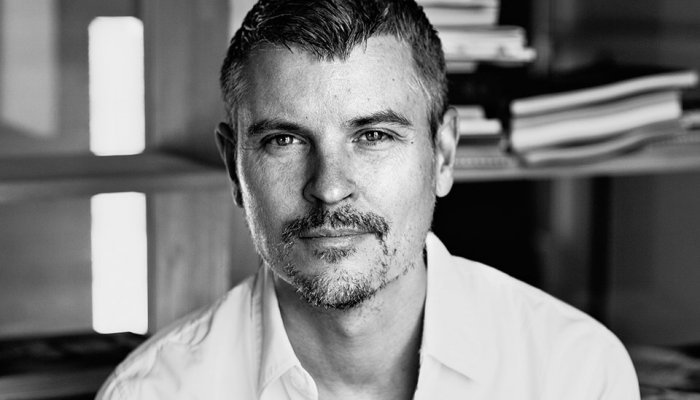Our study of over 100 global cases published in our new book, Distinguishers – Winning Customers at Speed, Scale and Lower Costs, reveals how they do it. There is a recipe.
Distinguishers are obsessed with getting people to do different things, not just use the technology to do what’s always been done digitally. As a result, they change customer behaviour at scale, deliver new and better outcomes, and radically alter the market.
Uber forever changed the way people get around. No more bookings, delays and frustrations with conference venues thanks to Zoom, which connects people and teams in shared spaces virtually on demand. Capitec and Livestock Wealth allow fractional ownership of shares and assets to people who would never previously have been able to access them.
They shake up
Distinguishers are not afraid to disrupt the status quo, whether in an existing enterprise or a new start-up. Determined to get rid of old stale brands and industries, they bring in the new, rather than just push to improve products and services.
They make an educated hypothesis based on an intuitive sense of what markets want, though markets may not know it or ask for it. Who asked for an Uber, Zoom or Netflix? Yet today, we all use them.
It’s seldom an incumbent who deliberately sets out to change customer behaviour and markets (we call them extinguishers in our book and explain why). So why didn’t a big brand in the travel industry initiate the virtualisation of touring and educational experiences instead of waiting for Amazon to do it? Or Skype become Zoom? Or a large restaurant chain create virtual kitchens and become Uber Eats? They didn’t, and that’s why distinguishers often displace extinguishers.
But, attracting new customers can mean a totally new lease on life for those incumbents who do become distinguishers. Having discovered pre-Covid-19 that most UK customers only have a two-week buffer before they get into debt, Natwest is changing customers banking behaviour to save more, enticing new customers into its fold.
They shape up
Distinguishers are in touch with the movements and currents of the times, which they convert into unique propositions.
They either switch the behaviour of their existing customers and create something entirely new – which Capitec did when it teamed up with Easy Equities to allow the masses excluded from the stock market to buy part shares – or they start something from scratch:
- In just four years, Zoom has become an indispensable global collaborative remote communication tool.
- Spotify and Netflix got an increasing number of customers to listen to music and watch videos in any place, at any time, and from anywhere, without buying or owning anything physical.
- With its B2B e-commerce platform to empower small businesses (800,000 merchants use their platform now), Shopify is as competitive as the larger firms without having built their own infrastructure.
Distinguishers often look to convert what was idle, ignored or invisible into value. It is just astounding that people would rent out spare space in their homes to strangers and that these strangers would become friends and part of a community.
Livestock Wealth has tapped into ‘the 100 million cow potential in Africa’ in which consumers can now invest without being impacted by financial market volatility. The idea is to free up the hidden value of small farmers and their holdings, a market underserved, and get the global crowd to buy a cow, either whole or in part, as an alternative to financial shares or unit trusts.
As they grow and demand increases, distinguishers open up space for shared wealth by attracting opportunities for new players to join their ever-widening value-creating ecosystem. For example, Flexi Club, a South African startup (also in Mexico), enables people to invest in driver vehicles. Its purpose is to democratise cars for Uber drivers as a work investment instead of an expense, whereas previously, 70% would not have access to finance. Through its app, BBVA, the Spanish digital bank, allows Uber drivers to be paid immediately, and they scale swiftly at low cost by getting more spend per driver, offering them and their families loans, for example.
Distinguishers want a better world. Discovery Insure - now the fastest-growing short-term insurer in South Africa – changed driver behaviour to decrease the unusually high number of road accidents. SodaStream reduced the 150 billion plastic bottles each year by getting people to stop buying sparkling water in cans and plastic bottles and rather make sparkling water at home. ‘SodaStreamers’ now make more carbonated water than any other brand globally, and customers drink more water, which is good for them.
Distinguishers understand that there can be no trust without transparency (where a product comes from and how it was made). And without trust, there can be no sustained scaling. This has metamorphosed supply chain behaviour and made blockchain front and central to success. Transparent pricing in goods and services has become the new norm.
They speed up
In a world where everything is speeding up, doing things fast is as important as doing things differently. There are several reasons why distinguishers work faster.
Firstly, if Covid-19 taught us one thing, it’s that working fast without compromise is possible. For example, within two to three weeks of the pandemic, Discovery Insure executives working from home repurposed the entire system (complex as it was) from rewarding people for driving better over distances to rewarding them for staying home whenever possible. Likewise, Uber quickly introduced Uber Medics, rolled out into over 20 countries after a request was made by the Spanish health authorities to offer free and discounted rides to health workers, with drivers guaranteed full fees.
And distinguishers don’t look for consensus. They avoid time, money and energy spent on resistors and resistance, which holds things up. Instead, they actively seek to work with peers, employees, funders, sponsors and scaling partners who “get it” and see benefits, not just another cost.
They build agile organisations that are interconnected both inside and with members of their ecosystem, and they learn to learn fast.
Agile is not a structure — it’s a way of working. Old-fashioned waterfall processes and organisational charts transform into sprints and scrums (mini start-ups) with missions based on desired customer deliverables. Learning is not about how to follow the process better; it’s about getting the job done quicker. Likewise, quality assurance is not about following a process or filling out paperwork or ticking certain boxes. The result wanted for customers comes first.
Distinguishers also scale fast because once the investment is made in the technology that sets them ahead in delivering new customer outcomes, any adaptation required to scale into another market or country can be done very quickly – for example, enabled by artificial intelligence, Aerobotics, the South African startup that sold drones, satellites and sensors to become a crop productivity expert for farmers, catapulted into the US, Europe, Australia and Latin America at breathtaking speed. Once it had invested in data on trees and citrus fruit, it could quickly globalise at a low cost.
Distinguishers use different techniques to get adoption quickly through free trials and discounts, for example. But it only really works if the old ‘push-pull model’ actually gets reinvented. For example, Natwest turned the old banking model on its head by offering higher interest rates to those who put smaller amounts into savings more regularly than those with higher deposits. This got more people to start saving.
They scale up
Distinguishers have every intention of scaling from the outset, and they have a playbook.
No distinguisher scales a bad product – they get it right, acknowledging that overdoing it isn't the answer either (because it will slow things down). No brand had actually got the product right, so there was no real market take-up until Zoom got it to work. Uber moved with astonishing speed, but it was carefully crafted, making sure the experience was superb so that it would be talked about, and people would say, ‘It works. It’s easy. Try it’.
They drive demand using customers to bring in other customers. So, instead of extinguisher mass production and marketing shout, distinguishers scale using customers as their mouthpiece. It’s no longer what brands and enterprises say about themselves that matters – it is rather what customers say about them, which means every customer experience counts.
Word of mouth was a slow burner, but now, the internet makes it a viral phenomenon with high velocity and reach, with customers the new channel to market, irrespective of whether the offering is digital or physical. The importance of reviews, the use of ‘winfluencers’ and user cases, social proofing, content sharing, etc., are all part of their viral, low-cost and speedy paradigm. Spotify has scaled exponentially by getting artists and listeners to recommend, share and spread their service globally. They would not have been able to get there through paid advertising.
They are present on the screens of computers, mobile phones and other devices. Some people go as far as to say that without screen presence, there is no viralisation. It’s the new high street. Notwithstanding the importance of physical experiences, as more goods and services are being sought and bought through digital channels, brands need to be there. It’s part of the new direct-to-market, no-middleman movement.
Owned and earned presence is more powerful than bought since it’s more credible, and credible attention matters. People give it their attention because they engage with the brand voluntarily instead of when advertising interrupts and spams them.
Apps are preferred to get screen presence (always within a finger’s reach of a potential customer). However, there are millions of apps, although most are never used. Some 80% of mobile time is spent on apps. Still, because screen space is highly valuable, the app must be useful and the interaction constant, enabling distinguishers to scale globally, quickly and cost-effectively.
Distinguishers consciously build virtuous cycles of demand and supply, which elevates their offerings causing stickiness, increased revenue per customer, new customers enticed in and a more solid barrier to entry. For example, Netflix created the demand for instant streaming entertainment, which drove suppliers to provide content, which brought in more customers, which lifted both the quantity and quality of content supplied including its own (to an Oscar-winning standard), which brought in still more customers. Likewise, with increasing numbers of small businesses subscribing to Shopify, open-source and API technology enables developers to access data and build on top of its platform, increasing the services offered, which brings in more customers, including those with more sophisticated requirements.
Reach and range are used as scaling levers, adding more products and services to existing customers as well as getting to new customers and new countries at a very low cost very quickly.
SodaStream continues to get market multiplication by getting increasing numbers of customers to switch behaviour to its machines and increasing its range with new products and services such as beer, tea, and alcohol, made at home with carbonated water. Bought by Pepsi, it also offers customers the opportunity to make various Pepsi sodas at home. Similarly, Livestock Wealth keeps scaling by building its array of fractional investment agricultural assets, for example sugarcane, macadamia nut trees (South Africa is the world’s largest producer) and maize.
Reach means getting to new customers and countries quickly and cost-effectively as Discovery Insure did when it took its offering to corporate fleets and rentals with swift results and into Saudi Arabia, which was up and running within seven months. And it could have been quicker if language wasn’t an issue. Or as Aerobotics has done in its swift 18-country scaling feat.
The point is that if what the distinguisher brand knows how to do better than anyone else for customers keeps improving through learning that is digitally driven, once the first-wave investment is covered, scaling can be done at high speed and low cost because the marginal cost of scaling, i.e., the next item, next customer, next configuration or next country, is low and keeps getting lower at incredible speed.
Distinguishers use a different economic model. They know that units of products and services, no matter how good they are, invariably lose value over time, but customers gain value. So, the upfront investment is about delivering superior, hyper-personalised outcomes to hold onto customers and then getting more value per customer at low cost by continuing to give them more value at low cost.
At the outset, the investment will bring a period of negative returns, but when the distinguisher reaches the tipping point, disproportionate gains kick in.
Part of the distinguisher’s game plan is to pass on these benefits to customers as lower prices/premiums, rewards, incentives, trials, discounts, free delivery, etc. This allows them to retain their customer base and gain access to and win more customers. This keeps them scaling at speed and low cost in a positive loop. Just what a distinguisher needs – to get and keep ahead.
Agile is not a structure — it’s a way of working.
Professor Sandra Vandermerwe is an Extraordinary Professor at GIBS, specialising in customer-focused transformation. Her academic work is based on ongoing, application-driven research and collaboration with well-known thinkers and practitioners and
has been published by leading academic journals.
After founding world-renowned Hyper Island – dubbed ‘the Oxbridge of Digital’ – David Erixon spent a decade in senior leadership positions at Vodafone, including five years as global brand director. David has worked on numerous industry projects, corporate accelerators, research initiatives and executive training focusing on customer-centric digital innovation and business transformation. David is an associate of Trinity Business School in Dublin and a marketing director at NatWest Group.








